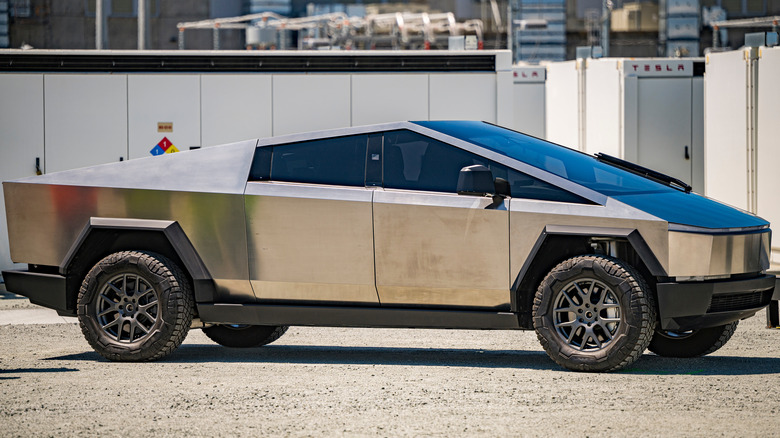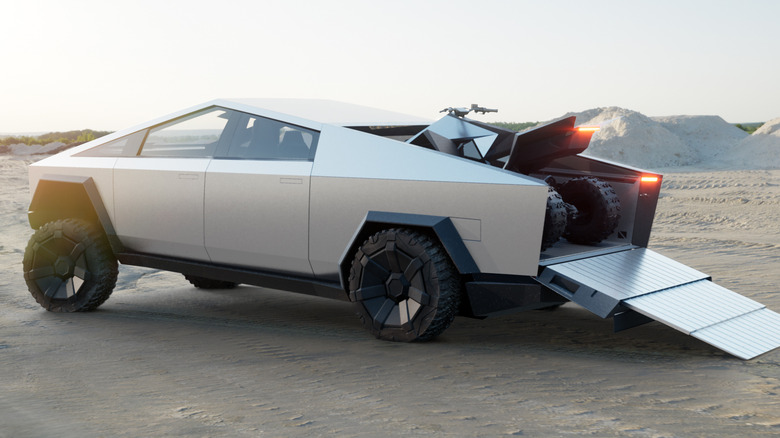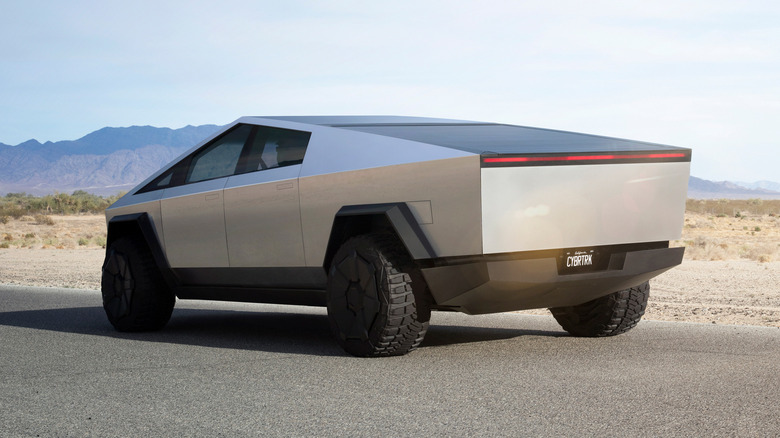Every Impressive Damage Test The Tesla Cybertruck Has Survived (And Which Defeated It)
Tesla's first round of Cybertruck deliveries will happen in late November 2023. The odd-looking electric truck has been the subject of chatter over its unconventional design and Elon Musk's bold claims about its tech credentials. One aspect, in particular, that the company has been heavily marketing is the car's sturdiness — after all, you don't put a vehicle riddled with bullet marks out on a public road without the explicit intention of grabbing eyeballs and spilling digital ink.
The extended development process and hyper-focused coverage of the Cybertruck's evolution have meant extra attention has been paid to tests that other vehicles usually pass without notice, such as crash tests and other damage tolerance assessments. True to his mercurial personality, Musk has arranged some atypical testing stunts to stir hype for the EV pickup.
Among them is letting podcaster Joe Rogan shoot an arrow at it, as well as asking another person to swing a sledgehammer at the electric car's door. However, not all those demonstrations of material strength and structural integrity have yielded the desired outcome. What follows are incidents of both failure and survival when the Cybertruck went against weapons ranging from a steel ball to a Tommy gun.
Steel ball vs. Tesla Cybertruck
The first, and arguably the most memorable, test of the Cybertruck's physical might unfolded in 2019 when Musk asked design lead Franz Von Holzhausen to throw a steel ball at the glass window. At the other end of the metallic projectile assault was the Tesla Armor Glass. To Musk's surprise, the window shattered. "Well, maybe that was a little too hard," Musk remarked. Another throw followed, this time on the rear window. That cracked, too.
Yup. Sledgehammer impact on door cracked base of glass, which is why steel ball didn’t bounce off. Should have done steel ball on window, *then* sledgehammer the door. Next time …
— Elon Musk (@elonmusk) November 25, 2019
This was preceded by the same ball being dropped vertically on Tesla's special glass and a normal car glass. The former shrugged off the impact, while the latter cracked. Now, we're almost tempted to explain the physics of why steel doesn't generate the same kinetic energy from a vertical fall that it does charging ahead with more impact energy when it is thrown directly at the glass, but that's not the point here. In this instance, the Cybertruck earned mixed marks.
Franz throws steel ball at Cybertruck window right before launch. Guess we have some improvements to make before production haha. pic.twitter.com/eB0o4tlPoz
— Elon Musk (@elonmusk) November 23, 2019
"Guess we have some improvements to make before production haha," Musk later posted on X, formerly Twitter. Maybe it was the demo unit on stage that was to blame for a bad outing. In a video shared by Musk on Twitter, the same Tesla executive can be seen throwing a steel ball at the Cybertruck's window, and it bounced right off without leaving a scratch. We'll have to wait for an ambitious customer to do an independent test to find out how the production version holds up.
Sledgehammer vs. Tesla Cybertruck
At the same demonstration event in 2019, Musk proclaimed that Tesla fabricated the Cybertruck's exoskeleton out of "ultrahard stainless steel." He then invited design lead Franz, who was wielding a sledgehammer, to take a swing at the car, while asking him not to hold back. The Tesla executive started by smashing a regular — and unnamed — car's door frame, leaving deep indentations with each hit.
Musk then asked him to target the Cybertruck's door, goading him to "hit it harder"; the truck shrugged it off. No marks were to be seen, and the audience went into a cheering frenzy. Now, a road-legal consumer car doesn't often run side-first into a sledgehammer, so the live demonstration might seem like an unrealistic test. However, it does serve as a reasonable sign that the Cybertruck is strong and extremely resilient to blunt force impact.
Do keep in mind that when a regular vehicle's metal frame caves in following an impact, it also ends up absorbing a healthy portion of the mechanical shock. But if it's a solid hunk of metal that doesn't absorb impact momentum, it's distributed across the entire frame and could end up displacing the car. The sledgehammer test of the Cybertruck was a success for Tesla, but we'll have to wait for crash test results and other demos to see how the Cybertruck actually fares in real-world scenarios. Also, it's possible that a sledgehammer can weaken the armored glass' integrity, according to Musk, so there's that.
Arrow vs. Tesla Cybertruck
As with the sledgehammer demonstration, it's hard to imagine how a vehicle could run into a flying arrow in the 21st century. Regardless, if you demonstrate that the Cybertruck's chassis can thwart an arrow, it makes for a great show that can help sway public opinion. Musk, a frequent guest on Joe Rogan's podcast, invited the UFC commentator to try out his compound bow on the EV pickup — and it didn't end disaster.
Rogan mentioned that the 90-pound compound bow he used shoots an arrow of around 525 grains at roughly 300 feet per second. When shot straight at the Cybertruck's door, the metallic head was flattened and the arrow shaft bounced off following a brief spark caused by metal impacting metal; a small dent at the impact site resulted. Rogan seemed impressed, but Musk warned that a "crossbow might get in."
Musk later said in a tweet on X that an arrow like the one shot by Rogan "would easily go through a normal car." Should you be worried about an arrow piercing the door of a car that is not the Cybertruck? Well, that would depend on the bow's power and launch distance. If this video is any indication, a compound bow may not fully penetrate an average car's door, but it would likely pierce through one layer of metal. We can at the very least conclude that a Cybertruck would make a reasonable 11th Century siege weapon.
Bullets vs. Tesla Cybertruck
All the "strength tests" mentioned above might sound absurd unless you plan on going back in time to an era when enemies might use metal balls, arrows, and hammers against you. Musk wants to send home the message that Tesla's electric pickup can also survive modern-era hostile situations, such as an "Al Capone style" hailstorm of bullets. "It is, it is literally bulletproof to a nine millimeter handgun," Musk claimed in 2019.
BREAKING: Cybertruck seen on the highway potentially gone through bullet proof testing 📐👽🤯
Seen by member of the club. pic.twitter.com/wBr9mNrLl7
— Tesla Owners Silicon Valley (@teslaownersSV) October 20, 2023
Tales of the Cybertruck's gun-proof nature first emerged when a unit bearing dozens of apparent bullet holes across the side profile was spotted cruising on a highway at night. Barring an extreme adventure, it was apparent that the car went through bullet testing. It was later confirmed by none other than Musk himself that the folks over at Tesla unloaded the full drum magazine of a Tommy gun at the EV.
"No bullets penetrated into the passenger compartment," the Tesla chief wrote in a post on X. Musk later talked about it on Rogan's show and argued that "trucks are supposed to be tough." Bulletproofing a car is quite a hit on the wallet, so it's reassuring to know that the Cybertuck will offer that kind of protection without an extra charge.
Tesla Cybertruck crash test
Now, let's move on to the most meaningful strength showcase of them all: a real crash test. So far, neither Tesla nor an external agency has shared the results of the mandatory crash tests for the Cybertruck. However, Tesla has indeed performed internal crash tests as evidenced by the still images that have made their way to social media platforms. Drone shots of a crash-tested unit show a Cybertruck with a caved-in frunk, a partially dislodged door, and damage to the front glass, for example.
NEWS! 1st verified crash tested Cybertruck at Giga Texas! Here are four images from the north end of the crash testing facility. Looks like front end and airbags deployed. @greggertruck @SERobinsonJr @TeslaPodcast pic.twitter.com/50JKcKRlZM
— Joe Tegtmeyer 🚀 🤠😎 (@JoeTegtmeyer) October 2, 2023
A video shared in the Cybertruck Owners Club Forum purportedly shows a unit after having gone through a ditch rollover test. A sticker on the EV's side suggests it was sent to MGA Research Corporation for testing. The windows appear damaged, the roof looks bent, and the airbags are deployed. However, another image of a Cybertruck posted on X, with a "Completed Crash Ready" sticker on it, shows almost no damage on the truck's visible region.
Since these are not official results, it's hard to predict whether the Cybertruck passed or failed the crash tests. What we do know is that the pickup features a "new metal," according to Musk on X. Technically, it's a steel alloy that is described in a Tesla patent as "ultra-hard cold-worked steel alloy." In 2019, Musk noted that the Cybertruck's exoskeleton is made out of an ultra-hard, cold-rolled stainless steel alloy that was developed by Tesla and is also used in the Starship's engineering.


